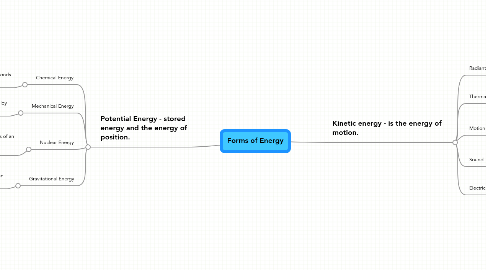
1. Kinetic energy - is the energy of motion.
1.1. Radiant Energy
1.1.1. This energy is electromagnetic and travels in transverse waves.
1.1.1.1. Some examples of radiant energy are visible light, x-rays, gamma rays, radio waves, sunshine, and light.
1.2. Thermal Energy
1.2.1. This energy is the vibration and movement of the atoms and molecules within substances.
1.2.1.1. An example of thermal energy is geothermal energy, which is in the Earth.
1.3. Motion Energy
1.3.1. This energy is stored in the movement of objects.
1.3.1.1. The faster the object moves, the greater the amount of energy stored. The energy is released when the object slows down.
1.4. Sound
1.4.1. This energy is movement of energy through substances in longitudinal waves.
1.4.1.1. Sound is produced when a force causes an object to vibrate.
1.5. Electrical Energy
1.5.1. This energy is delivered by tiny charged particles called electrons, typically moving through a wire.
1.5.1.1. An example of electrical energy is lightning.
2. Potential Energy - stored energy and the energy of position.
2.1. Chemical Energy
2.1.1. This energy is stored in the bonds of atoms and molecules.
2.1.1.1. Some examples of chemical energy are batteries, biomass, coal, natural gas, and petroleum.
2.2. Mechanical Energy
2.2.1. This energy is stored in objects by tension.
2.2.1.1. Some examples of mechanical energy are compressed springs and stretched rubber bands.
2.3. Nuclear Energy
2.3.1. This energy is stored in the nucleus of an atom. It is what holds the nucleus together.
2.3.1.1. This energy is used in the process of fusion and fission.
2.3.1.1.1. Fusion - The sun combines the nuclei of hydrogen atoms.
2.3.1.1.2. Fission - The nuclei of uranium atoms are split.
2.4. Gravitational Energy
2.4.1. This energy is stored in an object's height.
2.4.1.1. An example of gravitational energy is riding a bicycle down a hill and picking up speed. The heavier the object the faster it goes.
